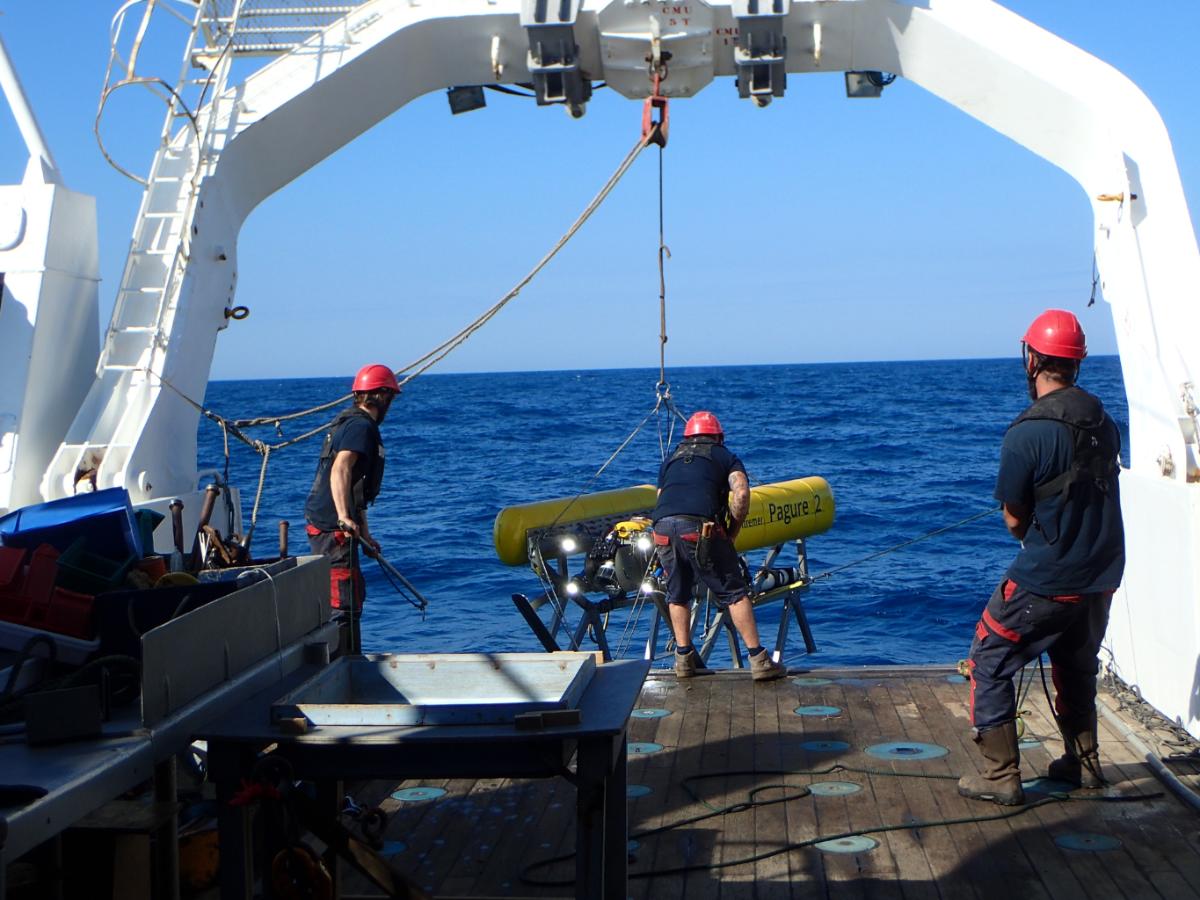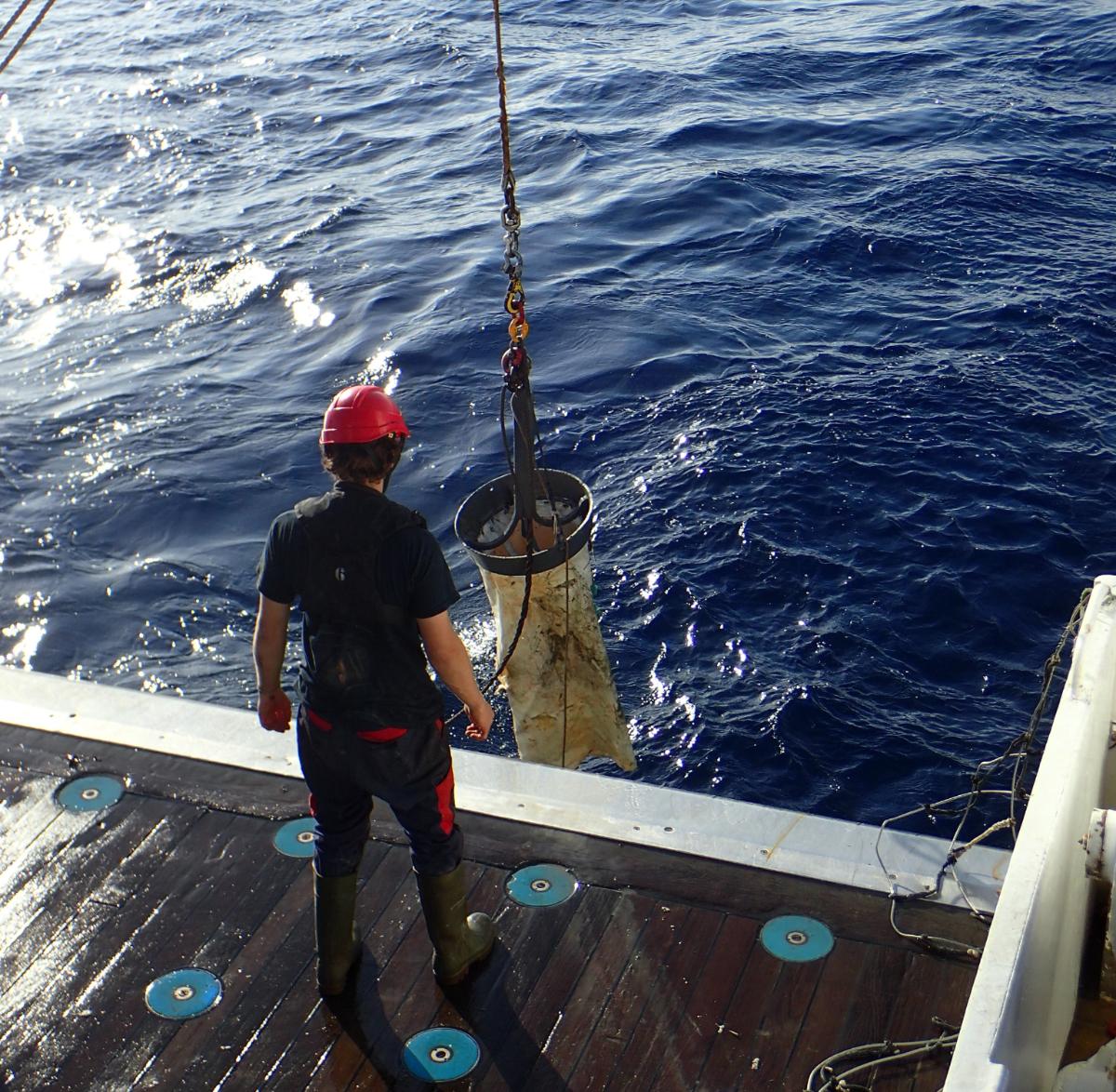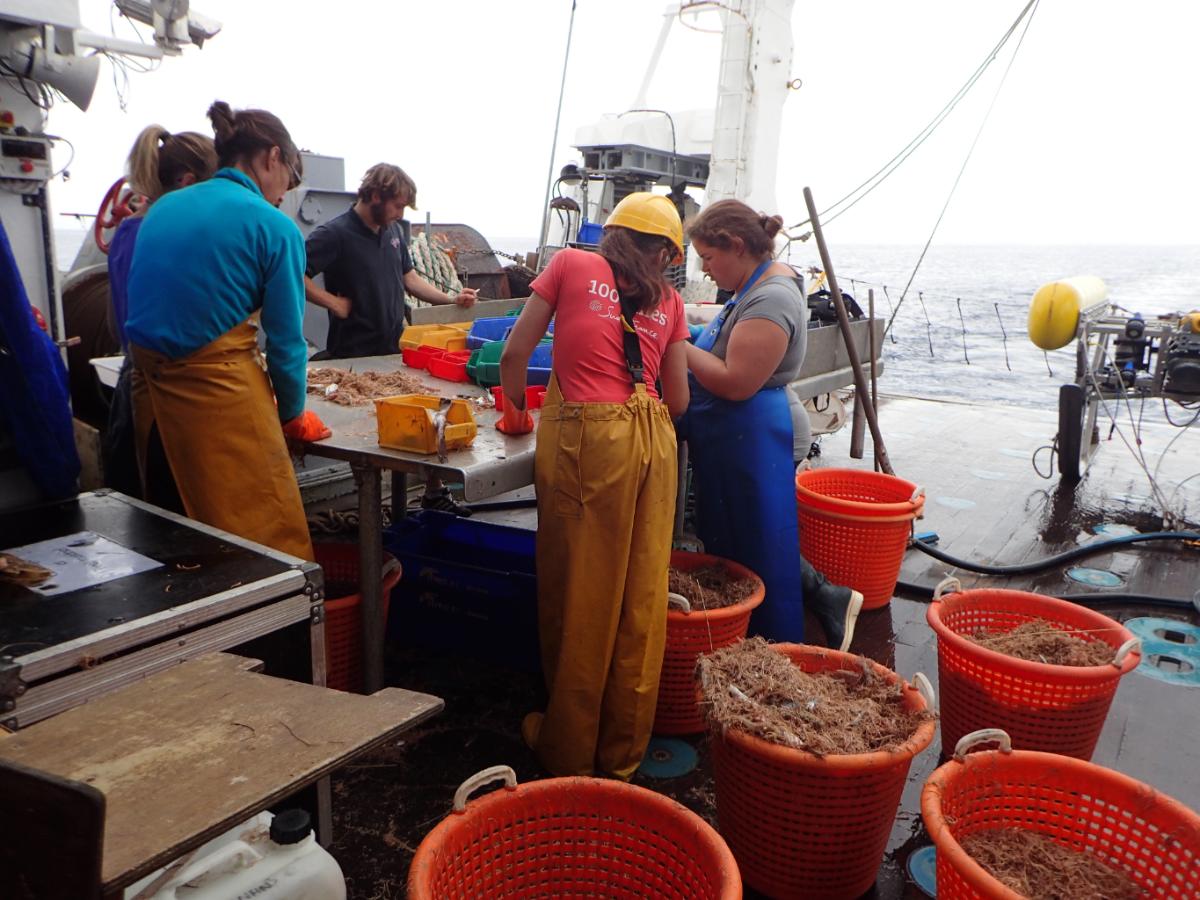1) Detecting the harmful effects on the integrity of the seabed
The benthic fauna of Europe's continental shelves is a community seriously affected by intense bottom trawling activity. The effect of trawling can depend on the spatial and temporal distribution of abrasion, the type of habitat, including the intensity of natural disturbance, and the fishing gear used, and there is an urgent need to identify or develop indices that can measure the impact of trawling. To this end, benthic fauna data obtained in scientific bottom trawl surveys covering the English Channel, the North Sea and the north-western Mediterranean were used and compared with the intensity of abrasion induced by fishing on the seabed. Fifteen indices were analysed: taxonomic diversity metrics, functional diversity indices and functional indices, the last two being based on traits of sensitivity to physical abrasion. Their properties, such as their ability to detect trawling, their statistical behaviour or their capacity to provide information on community structure, were studied. Among them, four indices specific to the detection of the effects of fishing based on biological traits seemed to be the best performing benthic indices in relation to these requirements: trawl disturbance index (TDI), modified trawl disturbance index (mTDI), partial trawl disturbance index (pTDI), modified sensitivity index (mT). Maps of the seabed sensitivity distribution captured by each of these four indices were produced. This work has highlighted the need to use specific indices to monitor the impact of trawling on benthic communities, but also that the use of different indices may be necessary to carry out this monitoring in all European waters.
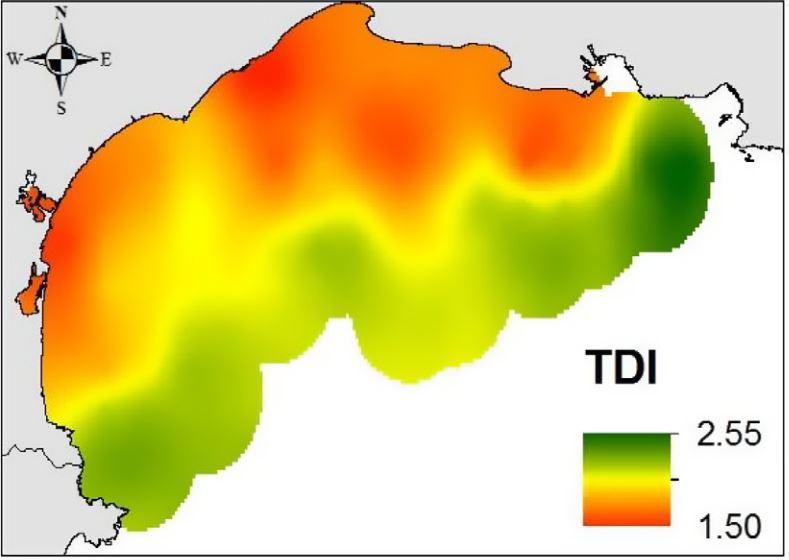
Spatial distribution of benthic sensitivity to trawling in the Gulf of Lion (MEDITS, EPIBENGOL)
The impacts of trawling depend on the spatial and temporal distribution of fishing effort, fishing gear, the intensity of natural disturbances and habitat types. Thus, for each indicator, threshold values need to be defined and a new conceptual approach for defining and detecting seabed integrity thresholds has been proposed. A modelling approach was used to determine abrasion threshold values for each habitat (EUNIS habitat map). The values beyond which trawling has an adverse effect on benthic communities were determined for each habitat. This enabled the ecological status of each habitat to be assessed and mapped, and the percentage of each habitat impacted by trawling to be determined. The method proposed here to assess the impact of trawling on benthic communities has shown that for the vast majority of the regions studied, these communities have suffered a negative impact or have been lost as a result of the intensity of trawling on the seabed.
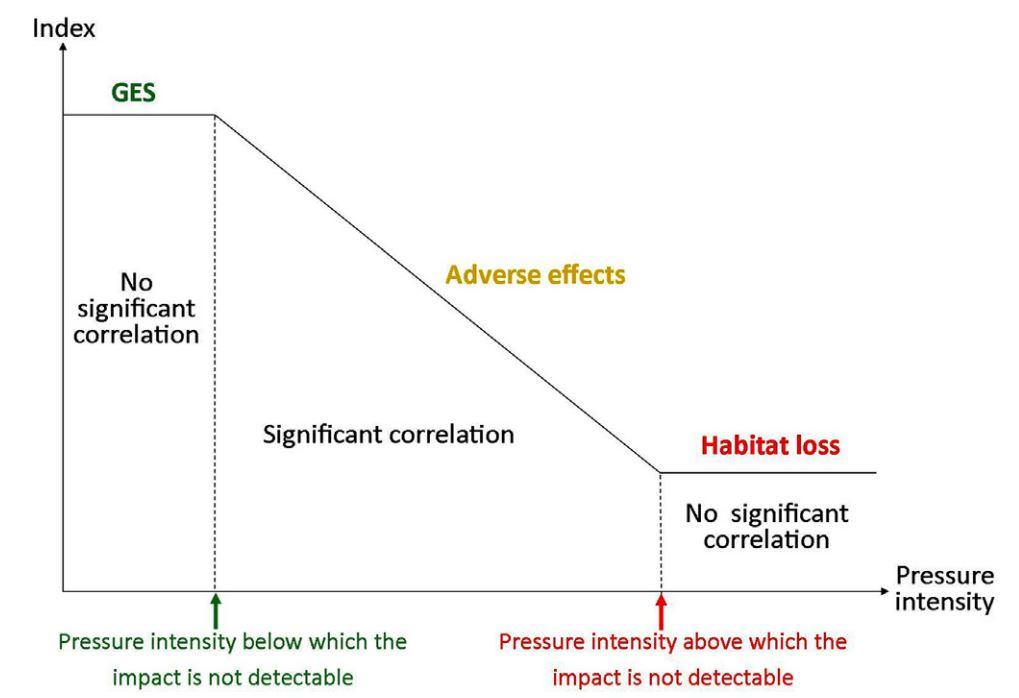
Schematic relationship between an index, the intensity of a given pressure and the corresponding ecological status.
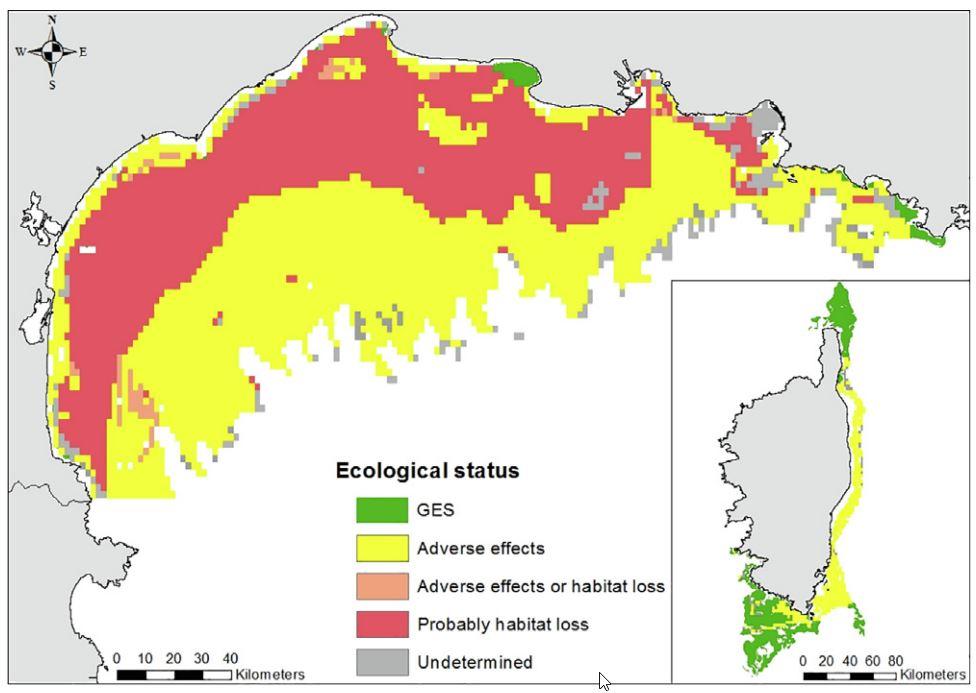
Ecological state of benthic habitats in relation to bottom trawling
2) Disentangling the impact of trawling from natural variability on benthic communities
Various environmental parameters such as temperature, depth and currents influence the composition and distribution of benthic assemblages. However, the impact of trawling on benthic communities depends on their specific composition, since not all benthic species are equally sensitive to trawling. In addition, trawling can have effects on benthic species similar to certain natural disturbances, such as a local increase in turbidity. Species adapted to these natural disturbances may be resistant to a certain level of trawling. It was therefore important to assess the joint influence of the environment and trawling pressure on the sensitivity of benthic communities in the English Channel, the Gulf of Lion and the east coast of Corsica. The environmental parameters were divided into two groups according to the type of influence they have on the benthic community. The first group of variables, used to model 'Scope for Growth' (SfG), concerns the resilience of species, while the second, 'Disturbance' (Dist), concerns their resistance to physical impacts. This work has shown that the distribution of benthic species in the Channel is mainly linked to physical disturbance and therefore to their resistance, whereas it is mainly parameters linked to the resilience of communities that influence the distribution of benthic fauna in the Mediterranean. The effect of abrasion could be distinguished from natural environmental disturbances in the Channel and the Gulf of Lion, where trawling was found to have a significant effect on functional sensitivity indices. The composition and distribution of benthic communities in Corsica do not appear to be influenced by trawling pressure.
3) Assessment of the impact of trawling on the seabed using video-submarine photography
Because of its non-destructive nature and its ability to focus on benthic macro-epifauna, sampling using a towed video system should also be considered to estimate the impact of trawling on benthic communities.
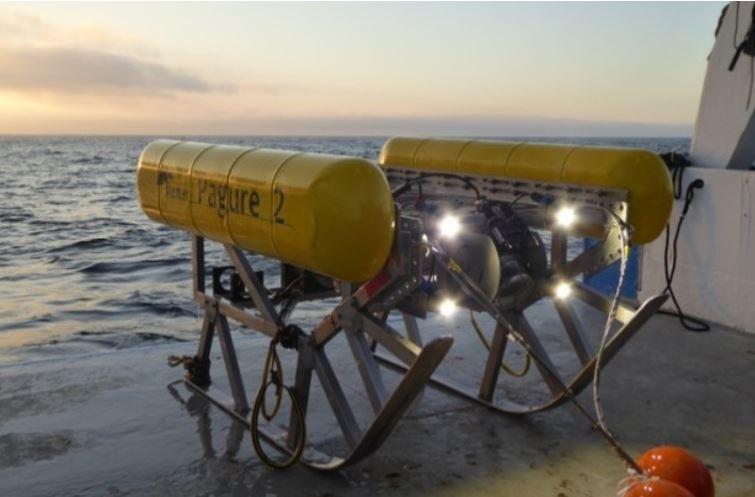
PAGURE towed video sled on the EPIBENGOL survey
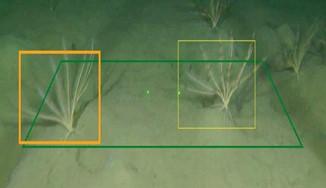
Example of organisms detected and counted by video (here a facies with Leptometra phalangium during the EPIBENGOL survey)
A study of the taxonomic and functional differences between the communities sampled by trawl and by video was therefore carried out. The influence of the characteristics of the video system (e.g. image quality) and abrasion on nine indices that could be used to monitor the effect of trawling on benthic communities was studied. Of these, three specific indices for detecting the effects of fishing based on biological characteristics were found to be the most effective with video data: the modified Trawling Disturbance Index (mTDI), the partial Trawling Disturbance Index (pTDI) and the modified sensitivity index (mT).

Relationship between trawl abrasion and the pTDI index. This relationship is negative and significant for all the habitat types observed (black line and dotted 95% confidence interval).
The effectiveness of these indices in monitoring the effect of trawling was evaluated and compared between data from scientific trawling and video sampling. This work has shown that video sampling can be a good alternative, or at least a complementary method, to destructive sampling methods for monitoring the effect of trawling on benthic communities.
4) Benthic sensitivity to bottom trawling in the French Mediterranean
The benthic habitats of the Mediterranean continental shelf have been subjected to high-intensity bottom trawling for decades. This has led to an erosion of benthic biodiversity and a degradation of seabed conditions. The ICES Working Group on Benthic Impact of Fisheries and Trade-offs (WGFBIT) has developed an evaluation framework, based on a life history trait, longevity, to assess the benthic impact of fisheries on a regional scale. This framework has been applied to the French Mediterranean.
Initially, Mediterranean databases on the longevity of benthic fauna were aggregated and a single database based on fuzzy coding of longevity classes was developed. It was then applied to benthic invertebrate by-catch data from French scientific bottom trawling surveys, including the EPIBENGOL data set. This database therefore made it possible to associate existing data on benthic biomass with the different classes of potential longevity of the species caught.
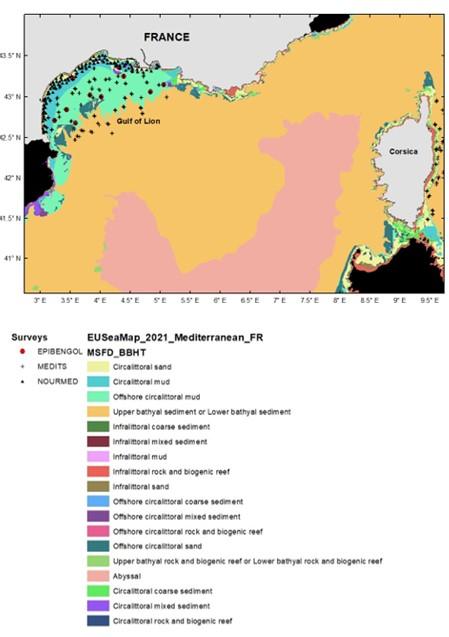
Map of the French EEZ illustrating the major habitat types of the MSFD and the survey data (here 2018) mobilised.
For each major habitat type (coastal circalittoral sand and mud, offshore circalittoral mud, bathyal sediment), a multinomial GLMM was fitted, linking biomass by longevity class to environmental predictors. This model was then used to predict the mean value of benthic community longevity under reference conditions as an indicator of benthic sensitivity. We predicted more sensitive habitats in the upper and lower bathyal sediments, and less sensitive habitats in the shallower muddy sediments.
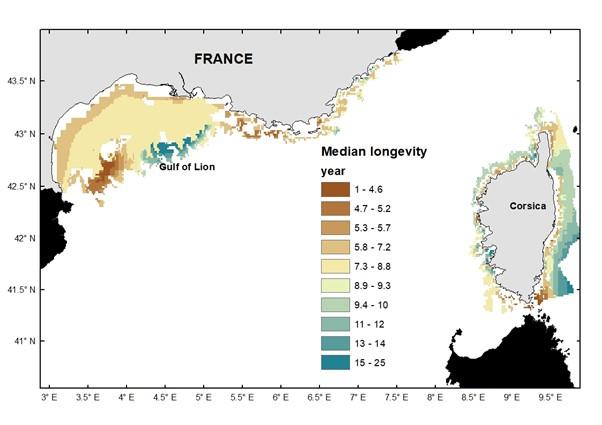
Median predicted longevity for the French Mediterranean (combining four different habitats).
Finally, the predicted longevity curve parameters were used to estimate local carrying capacity and benthic vulnerability (expressed as relative benthic status) based on known fixed depletion rates, observed biomass and abrasion rate. In line with previous studies, our estimate of relative benthic condition suggests heavily impacted areas close to the coast in the Gulf of Lion, and less impacted habitats around Corsica.
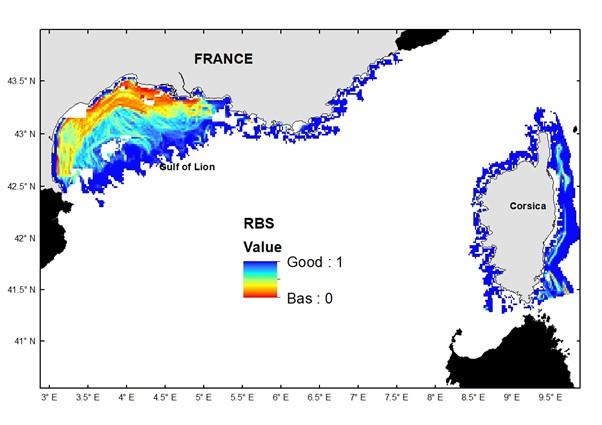
Relative benthic status for the French Mediterranean (combining four different habitats). The scale goes from 0 = poor state to 1 = good state.











